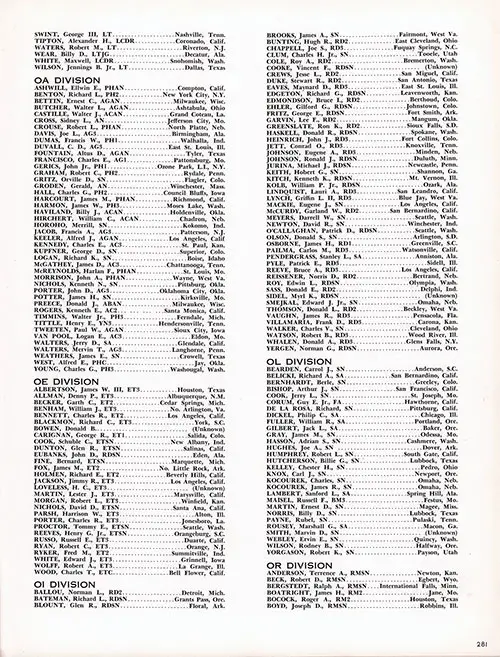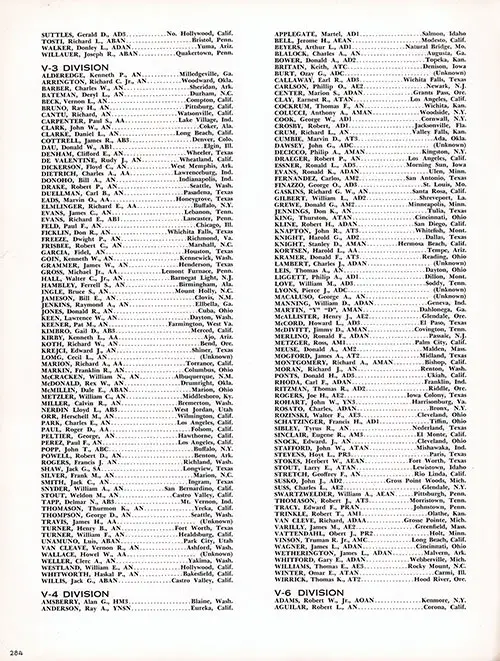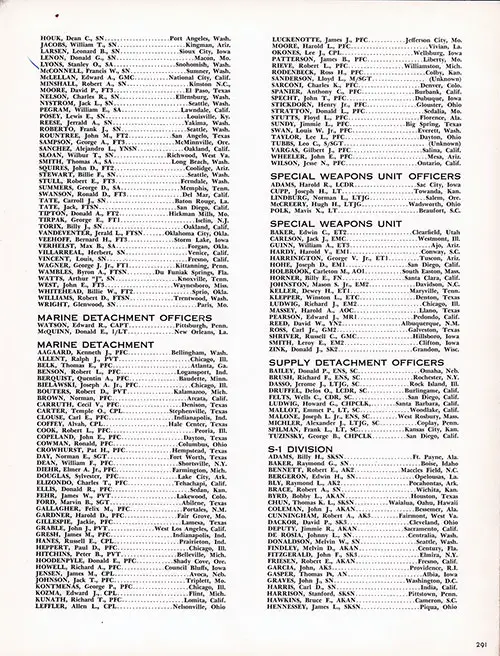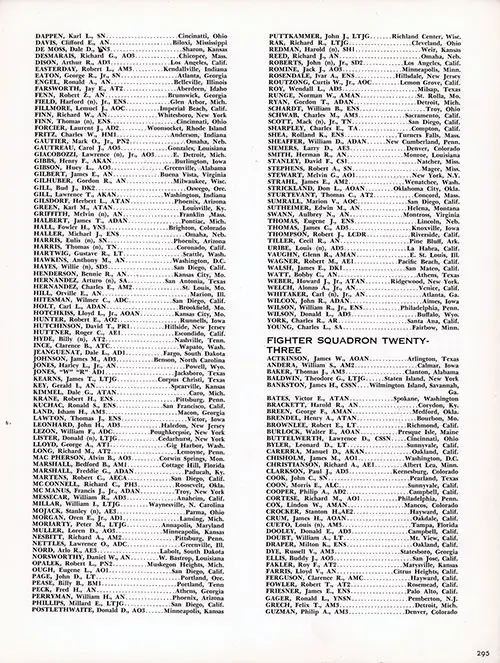USS Essex (CVA-9) — Third Far East Cruise, 1953–1954: Context, Rosters & Unit Guides

Front Cover, The USS Essex (CVA-9) Epic Third Far East Cruise, 1953-1954. GGA Image ID # 16d51691ce
“Quick Start” jump links: • Intro & Context • Dedication • Division Rosters • Air Wing • Marines • Special Weapons • Photo Det • Honorary Members
🔎 Page Review & Editorial Summary
This index page now functions as a true doorway to the cruise book: it sets context (1953–1954 world & Navy transitions), honors the fallen, and then guides visitors to 20 image-heavy roster sections with clear scoping text. As a research hub, it balances narrative and evidence: the historical preface makes the names meaningful; the roster-image grid proves provenance; the sectioned rosters create a navigable path through thousands of individuals without overwhelming the reader.
✨ What’s most compelling (and why)
Context-first introduction 🌍
The preface turns a list of names into a story of Cold War readiness, post-armistice Korea, and Pacific commitments. It’s the “why this matters” that keeps casual visitors reading—and gives teachers an instant lesson hook.
Dedication page 🎖️
The memorial roll humanizes the cruise. It’s emotionally resonant, photographically anchored, and naturally shareable on commemorative days.
Modernized “roles & units” blurbs ✈️⚡🛩️
The short explainers (VF / VA / VC / Special Weapons / Marines) are ideal “breathers” between rosters, translating Navy structure for general audiences without slowing researchers down.
High-fidelity roster images 🖼️
The sequential “Roster of Officers and Crew” panes (Parts 1–20) prove authenticity and help cross-check OCR or spelling variants—crucial for genealogists. The “Click to View a Larger Image” pattern is exactly right.
Owner’s marks & ephemera 🖋️
Items like “Owner’s Mark MU3 Ron Melbam…” connect the artifact to a person. These are “micro-stories”—excellent for social snippets and educator prompts.
Introduction: The USS Essex Cruise in Context (1953–1954)
The ESSEX EPIC is the story, in words and pictures, of the third Far East Cruise of the USS ESSEX (CVA-9), with Carrier Air Task Group Two embarked on its Third Tour in the Far East. To the reader who was not aboard, the EPIC represents a travelogue of the places we saw and the things we did. To the crew of the BIG NINE, it is a remembrance of eight long months aboard the "Fightin'est Ship in the Navy" on a peacetime cruise.
The ship has meant many things to us. . .. She has carried us off to distant lands, far from the ones we love. She has kept us up half the night on watch, then dragged us to our battle stations at dawn. She baked us in the firerooms and froze us on the flight deck. . . . But she's taken us many places, shown us many things, and made us a host of friends we'd never have had if it hadn't been for her. ... So, taking the good with the bad, it's been a good cruise and the best carrier in the Navy!
🌍 The World of 1953–1954: Context for the USS Essex Deployment
When the men of the USS Essex sailed during this period, they served against a backdrop of shifting world events that shaped their mission and daily life:
Korean War Armistice (July 1953): The fighting ended, but tensions remained high in the Pacific. Carriers like the Essex were still tasked with maintaining a strong American naval presence in Asia to deter renewed conflict.
Cold War in Full Swing: NATO alliances grew, the Soviet Union tested new nuclear weapons, and the U.S. Navy carried a critical role in demonstrating deterrence at sea. The Essex’s Special Weapons Unit reflects how nuclear readiness was already a part of carrier operations.
Indochina Conflict: France was losing its grip in Vietnam, culminating in the 1954 Battle of Dien Bien Phu. Carriers in the Pacific, including the Essex, trained for contingencies in Southeast Asia.
At Home in America: 1953–1954 were years of change—Dwight D. Eisenhower had become President, Jonas Salk’s polio vaccine was being developed, and rock ’n’ roll was just beginning to sweep across the nation. For sailors aboard, letters from home carried these cultural shifts onto the flight deck.
A Transitional Navy: The Essex-class carriers, built for World War II, were modernized to launch jet aircraft like the F9F Panther and AD Skyraider. This cruise sits right at the bridge between WWII-era seamanship and the jet-powered, nuclear-capable Navy of the Cold War.
For the men listed in the roster for this cruise, these events weren’t just headlines—they defined their mission. Understanding this context helps future generations appreciate why the USS Essex mattered and why her crew’s service remains significant.
Dedication: In Memory of Those Who Gave Their Lives
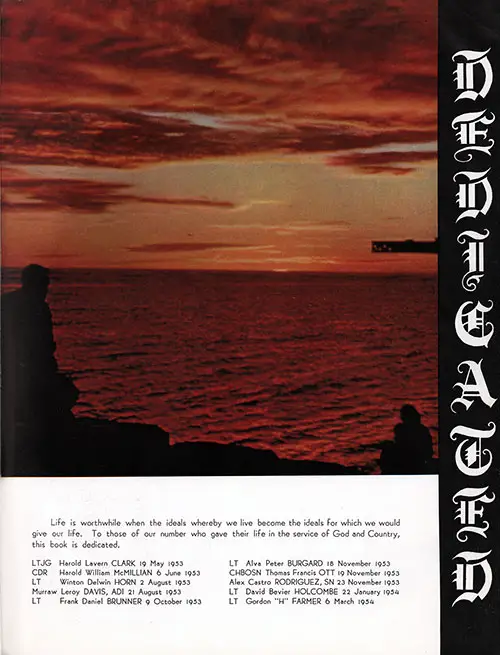
Dedication to Essex Crew Members Who Gave Their Lives in the Service of God and Country. GGA Image ID # 16dd483318
Life is worthwhile when the ideals by which we live become the ideals for which we would give our lives. To those of our number who gave their life in the service of God and Country, this book is dedicated.
- LTJG Harold Lavern CLARK - 19 May 1953
- CDR Harold William MCMILLIAN - 6 June 1953
- LT Winton Delwin HORN - 2 August 1953
- Murraw Leroy DAVIS, AD1 - 21 August 1953
- LT Frank Daniel BRUNNER - 9 October 1953
- LT Alva Peter BURGARD - 18 November 1953
- CHBOSN Thomas Francis OTT - 19 November 1953
- Alex Castro RODRIGUEZ, SN - 23 November 1953
- LT David Bevier HOLCOMBE - 22 January 1954
- LT Gordon "H" FARMER - 6 March 1954
HISTORY – 1954
The present ESSEX was launched and commissioned in 1942. It took twenty months to build her at an approximate cost of $ 69,000,000. During World War II, she earned the name of the fightingest ship in the Navy."
In 1949, she was dry-docked for redesigning and remodeling to enable her to handle larger and more powerful planes. She was recommissioned at Puget Sound Naval Shipyard, Bremerton, Washington, on 15 January 1951.
The cost of the remodeling was about $40,000,000. After shakedown and training cruises, she was ordered to Korean waters. She arrived in the combat zone on 21 August 1951.
The ESSEX returned from the first tour on 25 March 1952 and departed for Korean waters again on 16 June with Air Task Group TWO aboard. During the eight months of the second Cruise, her planes unloaded 31,000 bombs and rockets and more than a million rounds of machine gun fire on the enemy forces. Flying 7,606 sorties with Task Force 77 on this tour, the ESSEX planes participated in coordinated UN strikes all the way from the front lines to the Yalu River in North Korea, destroying over 1,100 buildings and damaging more than 500 others.
In close air support of UN front-line troops, ESSEX planes killed an estimated 500 enemy soldiers and smashed 144 bunkers.
On 2 September 1952, Captain Paul D. Stroop temporarily relieved Captain Rodee as commanding officer of the Essex. Captain B. B. C. LOVETT took command of the enormous ship just one month later.
The Essex returned to stateside on 6 February 1953, for a well-deserved rest, and entered the Naval Shipyard at Bremerton, Washington, for several months of alterations, repairs, and overhaul.
Although the ESSEX was the oldest carrier of her class, she now had the distinction of also being the most modern. Captain Christian H. DUBORG assumed command of the ESSEX on 2 March 1953, relieving Captain LOVETT.
On 1 December 1953, the ESSEX sailed from San Diego on her third tour of duty in the Far East since her recommissioning in January 1951.
The ESSEX was operating with Air Task Group TWO, and Rear Admiral Robert E. Blick, Commander Carrier Division THREE and Commander Task Force 77, was embarked.
On 13 February 1954, while operating in the East China Sea, Captain Frank Turner relieved Captain Duborg. He became the eleventh commanding officer of the USS Essex.
For 165 years, the vessels bearing the name USS ESSEX have been feared by their enemies and honored by the country they served. The present ESSEX, last and mightiest of her line, is the inheritor of a proud tradition that is almost as old as the United States itself.
25 JANUARY 1953 – YOKOSUKA, JAPAN
On 25 January 1953, the USS ESSEX sailed from Yokosuka Harbor, bound for home after seven months in Korean waters fighting a war which would never bring victory.
It was a war in which men shot to kill for two years after talks designed to end it were begun; it was a war in which falling bombs blew great holes in the harsh Korean earth for lack of better targets while the very arsenals of the enemy lay untouched in privileged sanctuaries a few miles away.
It seemed, sometimes, the most illogical, frustrating, and fruitless war in history, but it was a war that had to be fought. It was a cause that had to be defended. During this Cruise, five men from the ESSEX gave up their lives for that cause.
To the world, the Korean War was a "limited" war. To the pilots of the Essex, who faced enemy guns every day, and to the men who supported them, it was a war without limits.
It was a war of bombing, strafing, road and rail interdiction, and the air support of ground troops. It was a war of endless maintenance, spotting and respotting, tending boilers, and the myriad of other tasks that keep a great carrier underway and her planes in the air.
It was the deadly, dreary, monotonous war of flying circles around the Task Force, the search for submarines, and the drills, drills, drills for the attack which never came.
Lacking the goal of ultimate victory, what impels men to sacrifice for such a strange war as this on the other side of the world?
For some, it is the distance and remoteness itself, the mystery of strange new places and new experiences. For some, it is the resigned acceptance of a struggle we could not honorably avoid. For some, it is an appeal to reason and to abstract ideals. For all, it reflects a fierce pride in themselves, in their jobs, in their ship, and in their country.
Never before have men worked so hard and suffered so much for so few of the visible symbols of accomplishment and victory. Yet in their unselfish service, they brought to themselves and to their country a blazing, unforgettable glory—and that is, in itself, victory.
The men of the ESSEX could well feel proud that January evening as the ship weighed anchor in Yokosuka Harbor and headed for home and their loved ones who waited so anxiously for their return.

The USS Essex (CVA-9). For twelve dragging days and twelve sleepless nights, we steamed Eastward toward San Diego. Bright and early on Friday, 6 February, we lined up along the bow, searching for the first glimpse of Point Loma. Finally, it is sighted! We stand down the harbor at a snail's pace and then a thrilling spectacle emerges from behind the intervening buildings. . . . Thousands of people, bands, beautiful majorettes, scores of romping children and above it all, the brilliant colors of the gay dresses of our wives and sweethearts. . . . Our eyes blink to keep back the tears .... Tears for the brave boys we left in Korea and tears of thankfulness for being home. ... After a "WELL DONE" by COMAIRPAC, the gangway was lowered and wives, children, friends, and sweethearts scrambled aboard. . . . GGA Image ID # 16dd41fda1
USS Essex CVA-9 Third Far East Cruise 1953-1954 Rosters
Rosters: Section 1;
Section 1 Includes Commander Carrier Division Three, Chief of Staff, Carrier Division Three, Commanding Officers, Executive Officer, Administrative Department Officers, X Division, Operations Department Officers, OA Division, OE Division, Ol Division, OL Division, OR Division, OS Division, Navigation Department Officers, N Division, Medical Department Officers, H Division, Dental Department Officers, D Division, Air Department Officers, V-1 Division, V-2 Division, V-3 Division, V-4 Division, V-6 Division, and V-7 Division.
Section 2 includes the Helicopter Unit, Detachment Officer-in-Charge, Helicopter Unit One Detachment, Engineering Department Officers, A Division, B Division, E Division, M Division, R Division, Gunnery Department Officers, G-1 Division, G-2 Division, G-3 Division, G-4 Division, and G-5 Division.
Section 3 Includes F Division, Marine Detachment Officers, Marine Detachment, Special Weapons Unit Officers, Special Weapons Unit, Supply Detachment Officers, S-1 Division, S-2 Division, S-3 Division, S-4 Division, Commander Air Task Group Two, Fighter Squadron One Hundred Forty Three, Attack Squadron Fifty Five, Fighter Squadron Twenty Three, Fighter Squadron One Hundred Twenty Three, Composite Squadron Thirty Five Detachment, Composite Squadron Eleven Unit, Composite Squadron Three Team, Composite Squadron Sixty One Photo Detachment, and Honorary Members.
How to Use This Page (for Teachers, Genealogists & Researchers)
👥 Why this page matters (by audience)
Teachers & students 📚
Use the intro + unit blurbs as mini-lessons on Cold War naval aviation, logistics, and shipboard life. The page scaffolds inquiry: “Find a sailor in a division. What did that division do?”
Genealogists & family historians 🧬
Clear division labeling + legible roster images + your inline name standardization (rank → first → last → suffix; 0→O notes, known variants) = verifiable citations and fewer false positives.
Historians & naval researchers 🧭
The date-bound narrative + unit composition (e.g., Special Weapons, Marine Detachment, VC photo det) yields operational texture—how a post-WWII carrier actually deployed and trained.
Veterans, families, and the public 🇺🇸
The dedication and shipboard scenes (homecoming narrative, hanger/flight deck rhythm) are poignant, approachable, and respectful—perfect for Veterans Day / Memorial Day discovery.
🗂️ “Most interesting content” highlights
Special Weapons Unit ⚛️
A tangible marker of Cold War nuclear readiness—rarely explained clearly in cruise books.
Marine Detachment 🟩
Shipboard Marines in the jet era: security, ceremonial duties, and detachment leadership—great crossover with USMC research.
Composite & Photo Detachments (VC-35, VC-11, VC-3, VC-61) 🛩️📷
The Swiss-army-knife units: night attack, ASW, photo recon. Excellent for explaining the “composite” idea to newcomers.
Owner’s Mark & Annotations ✍️
Personal fingerprints that invite readers to ask, “Who was MU3 Ron Melbam?”—a perfect entry point for student inquiry.
The Homeward Bound narrative 🚢
Humanizes the ship with a vivid return scene—ideal excerpt for Veterans Day posts or classroom warm-ups.
- Start with the Introduction & Context for what was happening in 1953–1954.
- Browse the roster sections by division/squadron; click images to verify spellings and initials.
- Watch for standardized name forms (e.g., 0→O fixes) and check the original scan when in doubt.
- Use the unit blurbs (VF/VA/VC/Marines/Special Weapons/Photo Det) to understand each role aboard ship.
- For research papers or family histories, cite the roster image ID plus page/section title.
- New to Navy ratings? Open the “Ranks & Abbreviations” guide from any roster section.
USS Essex (CVA-9) — Third Far East Cruise • Fast Facts
- Hull & Class
- Essex-class aircraft carrier (CVA-9)
- Cruise Window
- Third Far East tour, Dec 1953–1954
- Air Group
- Carrier Air Task Group TWO (ATG-2)
- Embarked Squadrons
- VF-143, VF-23, VF-123; VA-55; VC-35 Det; VC-11 Unit; VC-3 Team; VC-61 Photo Det
- Marine Detachment
- Shipboard security, ceremonies, and embarked operations
- Special Weapons
- Onboard unit reflecting early Cold War nuclear readiness
- CO Change
- Capt. C. H. Duborg → Capt. Frank Turner (13 Feb 1954)
- Flag Afloat
- RADM Robert E. Blick, ComCarDiv THREE / CTF-77 embarked
- Aircraft Era
- Jet & prop mix (e.g., F9F Panther, AD Skyraider) during post-Korean Armistice
- Use Case
- Genealogy, unit history, classroom primary-source analysis
Tip: Each roster image includes a unique GGA Image ID—cite it with the section title for clean references. 📎
Additional Images for CVA-9 USS Essex Third Far East Cruise of 1953-54

Owner's Mark MU3 Ron Melbam Service No 735-10-40. CVA-9 USS Essex, Third Far East Cruise, 1953-54. | GGA Image ID # 233ae55a7d

Forward - The Essex Epic is the Story, in Words and Pictures, of the Third Far East Cruise of the USS Essex (CVA-9), with Carrier Task Group Two Embarked on its Third Tour in the Far East. CVA-9 USS Essex, Third Far East Cruise, 1953-54. | GGA Image ID # 233ae75874

History of the USS Essex 1954, Part 1 (1942-1952). CVA-9 USS Essex, Third Far East Cruise, 1953-54. | GGA Image ID # 233c2641d3

History of the USS Essex 1954, Part 2 (1952-1953). CVA-9 USS Essex, Third Far East Cruise, 1953-54. | GGA Image ID # 233b6d99a2

History of the USS Essex 1954, Part 3 (1953-1954). CVA-9 USS Essex, Third Far East Cruise, 1953-54. | GGA Image ID # 233b7656d5
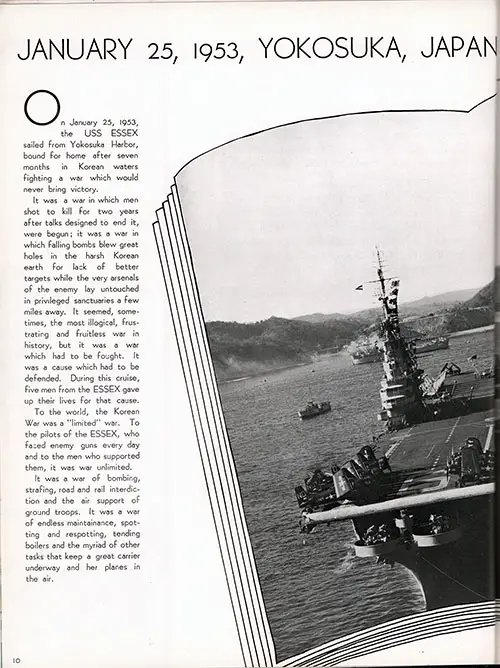
Homeward Bound, Yokosuka, Japan, 25 January 1953, Part 1. CVA-9 USS Essex, Third Far East Cruise, 1953-54. | GGA Image ID # 233bb857c9

Homeward Bound, Yokosuka, Japan, 25 January 1953, Part 2. CVA-9 USS Essex, Third Far East Cruise, 1953-54. | GGA Image ID # 233bcae1ba

View of the USS Essex Heading Out to Sea. CVA-9 USS Essex, Third Far East Cruise, 1953-54. | GGA Image ID # 233be78c91
Division & Air Group Rosters (Parts 1–20)
Roster of Officers and Crew, Part 1 (Commander Carrier Division Three, Chief of Staff -- Carrier Division Three, Carrier Division Three Officers and Staff). CVA-9 USS Essex, Third Far East Cruise, 1953-54. | GGA Image ID # 23370f2fe9. Click to View a Larger Image.
Roster of Officers and Crew, Part 2 (Commanding Officers, Executive Officer, Administrative Department, and Operations Department Officers (Barbour-Steen)). CVA-9 USS Essex, Third Far East Cruise, 1953-54. | GGA Image ID # 2336d5600e. Click to View a Large Image.
Roster of Officers and Crew, Part 3 (Operations Department (Swint-Tipton), OA Division, OE Division, OI Division, OL Division, and OR Division (Anderson-Boyd)). CVA-9 USS Essex, Third Far East Cruise, 1953-54. | GGA Image ID # 2336e0b87c. Click to View a Larger Image.
Roster of Officers and Crew, Part 4 (OR Division (Bradford-Wofford), OS Division, Navigation Department Officers, N Division, Medical Department Officers, H Division, Dental Department Officers, D Division, Air Department Officers, and V-1 Division (Alberty-Appleton)). CVA-9 USS Essex, Third Far East Cruise, 1953-54. | GGA Image ID # 233736a638. Click to View a Larger Image.
Roster of Officers and Crew, Part 5 (V-1 Division (Baxter-Williams) and V-2 Division (Allen-Stunkel). CVA-9 USS Essex, Third Far East Cruise, 1953-54. | GGA Image ID # 23373b9e54. Click to View a Larger Image.
Roster of Officers and Crew, Part 6 (V-2 Division (Suttles-Willauer), V-3 Division, V-4 Division, and V-6 Division (Adams-Aguilar)). CVA-9 USS Essex, Third Far East Cruise, 1953-54. | GGA Image ID # 23377d8115. Click to View a Larger Image.
Roster of Officers and Crew, Part 7 (V-6 Division (Ahearn-Yetter), V-7 Division, Helicopter Unit One Detachment Officer-In-Charge, Helicopter Unit One Detachment (Burkhalter-Leever)). CVA-9 USS Essex, Third Far East Cruise, 1953-54. | GGA Image ID # 2337a6ac88. Click to View a Larger Image.
Roster of Officers and Crew, Part 8 (Helicopter Unit One Detachment (Long-Zimmer), Engineering Department Officers, A Division, and B Division (Adams-Lamb)). CVA-9 USS Essex, Third Far East Cruise, 1953-54. | GGA Image ID # 2337c362ce. Click to View a Larger Image.

Roster of Officers and Crew, Part 9 (B Division (Lambert-Young) and E Division (Allen-Owen). CVA-9 USS Essex, Third Far East Cruise, 1953-54. | GGA Image ID # 233c2d3aa8
Roster of Officers and Crew, Part 10 (E Division (Patrick-Work), M Division, and R Division (Aldrich-Roth). CVA-9 USS Essex, Third Far East Cruise, 1953-54. | GGA Image ID # 2337d4c614. Click to View a Larger Image.
Roster of Officers and Crew, Part 11 (R Division (Satcher-Young), Gunnery Department Officers, G-1 Division, G-2 Division, G-3 Division (Adams-Comstock). CVA-9 USS Essex, Third Far East Cruise, 1953-54. | GGA Image ID # 23381cbf72. Click to View a Larger Image.
Roster of Officers and Crew, Part 12 (G-3 Division (Cox-Wright), G-4 Division, G-5 Division, and F Division (Austin-Henager). CVA-9 USS Essex, Third Far East Cruise, 1953-54. | GGA Image ID # 23382525d3. Click to View a Larger Image.
Roster of Officers and Crew, Part 13 (F Division (Houk-Wright), Marine Detachment Officers, Marine Detachment, Special Weapons Unit Officers, Special Weapons Unit, Supply Detachment Officers, and S-1 Division (Adams-Hennessey)). CVA-9 USS Essex, Third Far East Cruise, 1953-54. | GGA Image ID # 233838290c. Click to View a Larger Image.
Roster of Officers and Crew, Part 14 (S-1 Division (Herring-Wucher) and S-2 Division (Actkinson-Simms)). CVA-9 USS Essex, Third Far East Cruise, 1953-54. | GGA Image ID # 233889fda1. Click to View a Larger Image.
Roster of Officers and Crew, Part 15 (S-2 Division (Sklar-Zukauskas), S-3 Division, S-4 Division, Commander Air Task Group Two, Fighter Squadron 143 (Abell-Cezar)). NOTE: Handwritten Notation after the Names of Roesli WA2 5492 and Swayze WA2 6330 May Denote Advancement During or after deployment. CVA-9 USS Essex, Third Far East Cruise, 1953-54. | GGA Image ID # 2338ad2920. Click to View a Larger Image.
Roster of Officers and Crew, Part 16 (Fighter Squadron 143 (Charles-Zschomler) and Attack Squadron 55 (Adkisson-Cutrer)). CVA-9 USS Essex, Third Far East Cruise, 1953-54. | GGA Image ID # 2338f55243. Click to View a Larger Image.
Roster of Officers and Crew, Part 17 (Attack Squadron 55 (Dappen-Young) and Fighter Squadron 23 (Actkinson-Guzman)). CVA-9 USS Essex, Third Far East Cruise, 1953-54. | GGA Image ID # 2338ff4194. Click to View a Larger Image.
Roster of Officers and Crew, Part 18 (Fighter Squadron 23 (Hair-Wright) and Fighter Squadron 123 (Andrews-McQuary)). CVA-9 USS Essex, Third Far East Cruise, 1953-54. | GGA Image ID # 2339d4b8d3. Click to View a Larger Image.
Roster of Officers and Crew, Part 19 (Fighter Squadron 123 (Medcalf-Young), Composite Squadron 35 Detachment "ITEM," Composite Squadron 11 Unit ITEM, and Composite Squadron 3 Team "ITEM" (Barbee-Rushton)). CVA-9 USS Essex, Third Far East Cruise, 1953-54. | GGA Image ID # 233a0dc082. Click to View a Larger Image.
Roster of Officers and Crew, Part 20 (Composite Squadron 3 Team "ITEM" (Sanders-Wheeler), Composite Squadron 61 Photo Detachment ITEM, Honorary Members, and Annotations and Signatures from Several Sailors. CVA-9 USS Essex, Third Far East Cruise, 1953-54. | GGA Image ID # GGA233a6e4680. Click to View a Larger Image.
What the Units Did (VF / VA / VC / Marines / Special Weapons / Photo Det)
Honorary Members
Provenance & Notes on Spelling / OCR



